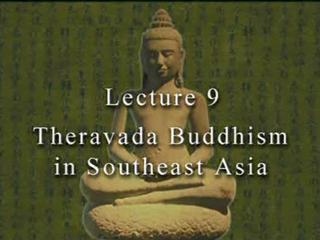The ninth and tenth lectures by Prof David Eckel on Buddhism look at the two main schools of Buddhism, Theravada and Mahayana.
Course Notes:

Under the reign of the Buddhist King Asoka, who reigned from about 268 to 239 B.C.E., the first Buddhist missionaries left India for Sri Lanka. From this missionary effort grew the Theravada (“Tradition of the Elders”) Buddhism that now dominates all the Buddhist countries of Southeast Asia with the exception of Vietnam.
Along with the Theravada tradition came the Buddhist concept of a “righteous king,” exemplified by Asoka himself. During the history of Theravada Buddhism in Southeast Asia, a close relationship has existed between the Buddhist samgha and Buddhist political leaders.
This relationship is evident Thailand, where Buddhist kings have played a key role in the reform and revitalization of the Buddhist samgha. It also plays a role in the work of Aung San Suu Kyi, who won the 1991 Nobel Peace Prize for her nonviolent resistance to military authority in Burma.
if the video does not appear on the page, try reloading the page; and if that doesn’t work, leave a comment so I can update the page (the comment is not published)
Course Notes:

Near the beginning of the common era, a movement appeared that called itself the Mahayana, or “Great Vehicle,” in contrast to the Hinayana, or “Lesser Vehicle.” The word “Hinayana” was used to refer to previous Buddhist traditions.
While Mahayana texts trace their origin to the Buddha himself, the actual origin of Mahayana remains a mystery. There is no mystery, however, about the fundamental teaching of the Mahayana. Mahayana texts promote the ideal of the bodhisattva, or “future Buddha,” who does not attempt to achieve nirvana as an individual goal but vows to return again and again in the cycle of samsara to seek the welfare of others.
if the video does not appear on the page, try reloading the page; and if that doesn’t work, leave a comment so I can update the page (the comment is not published)
to see an album of screenshots click here

